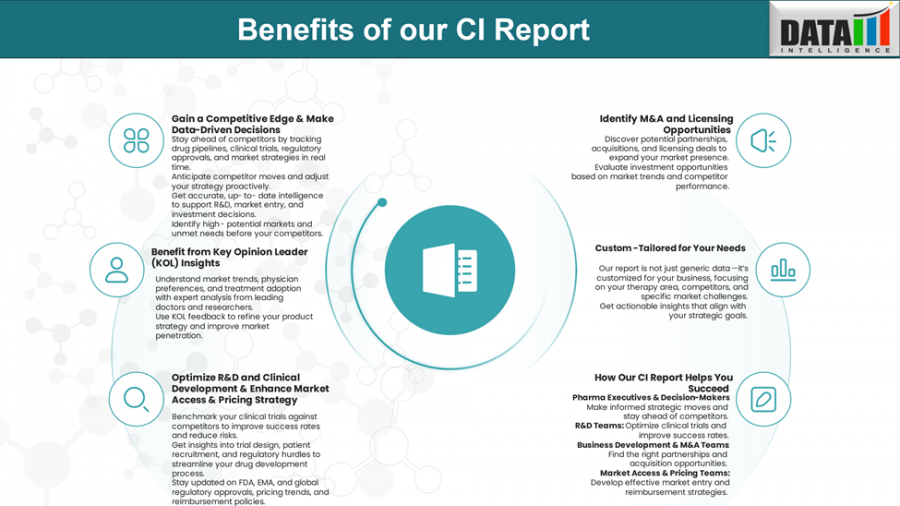
Geographic Atrophy in Focus: From Syfovre & Izervay Dominance to Oral, Gene & Cell Therapies Revolutionizing GA
GA treatment market heats up: Syfovre & Izervay lead, while oral, gene, cell therapies and AI‑enabled tools enter, with global growth and supply challenges.
AUSTIN, TX, UNITED STATES, June 24, 2025 /EINPresswire.com/ -- 1. Disease Mechanism & Pathophysiology
Geographic Atrophy is the advanced atrophic form of dry age-related macular degeneration (AMD), marked by progressive degeneration of the retinal pigment epithelium (RPE), photoreceptors, and choriocapillaris in the central macula. This degeneration culminates in irreversible central vision loss. Chronic inflammation driven by aberrant complement system activation—particularly components such as C1q, C3, and C5—leads to local cellular damage via opsonization, membrane attack complex (MAC) formation, and cell death. Lesions often expand from the periphery toward the fovea, leading to sharp declines in reading, driving, facial recognition, and overall visual function over 1.4 to 2.5 years once the fovea becomes involved
Download CI Sample Report: https://www.datamintelligence.com/strategic-insights/ci/geographic-atrophy-ga
2. Epidemiology & Diagnostics
- Prevalence: Affects around 5 million individuals globally, including approximately 1 million in the U.S.; incidence increases markedly after age 75, with those 75–79 years old representing the largest affected cohort .
- Diagnostic Imaging: Standard methods include fundus autofluorescence for delineation of atrophic areas, while OCT and OCT-angiography provide quantitative lesion tracking and choriocapillaris flow evaluation. OCT-A, in particular, holds over 38% share of diagnostic use due to its non-invasive vascular imaging capabilities.
3. Market Size & Growth Trajectory
- Market Valuation: Estimated at USD 23.7 billion in 2023, with projections reaching USD 50 billion by 2032—implying CAGR of ~8.6%.
- Regional Dynamics: North America (40–48% share) leads due to high prevalence, access to specialists, and major pharmaceutical investment. Europe follows, while Asia-Pacific is the fastest-growing region, driven by demographic trends and healthcare expansion.
- Clinical Development: Phase III programs dominate the pipeline (~34–50% share), with major players such as Apellis and Galderma actively advancing new therapies.
4. Therapeutic Landscape & Pipeline
Approved Intravitreal Therapies
- C3 Inhibition: Pegcetacoplan (Syfovre) slows lesion enlargement via broad complement suppression.
- C5 Inhibition: Avacincaptad pegol (Izervay) targets C5 to reduce inflammatory signalling with a potentially more favorable safety profile.
Late-Stage Pipeline Candidates
- C5 Intravitreal: Regeneron’s pozelimab offering similar efficacy with deeper retina expertise backing.
- Oral RBP4 Inhibitors: Belite's Tinlarebant and Alkeus’s Gildeuretinol aim to shift treatment from injections to daily tablets, reducing clinic burden.
- C1q Inhibitors: Annexon’s ANX007 introduces a novel complement target with potential neuroprotective benefits.
- Immunomodulatory Intravitreal Agents: Aviceda’s AVD-104 utilizes Siglec-targeted nanoparticles to dampen inflammation.
Next-Generation Modalities
- Cell-Based Regeneration: Roche’s OpRegen delivers RPE cells subretinally to repair degenerative tissue.
- Gene Therapy: J&J’s AAV-sCD59 (JNJ‑1887) attempts durable complement inhibition via a single injection.
Customize CI Consultation as per Your Business requirement: https://www.datamintelligence.com/strategic-insights/ci/geographic-atrophy-ga
5. Market Dynamics & Differentiation
Emerging therapies must deliver on several critical dimensions:
- Safety: Avoid intraocular inflammation, vasculitis, or retinal detachment seen with some complement inhibitors.
- Efficacy: Achieve superior lesion suppression and—ideally—functional improvements such as contrast sensitivity and reading speed.
- Mechanism Diversification: Engage novel pathways like C1q, RBP4, neuroprotection, or regenerative cell/gene platforms to serve non-responders.
- Administration: Move toward oral regimens or long-acting, sustained-release, gene- or cell-based, less frequent dosing.
- Durability: Aim for multi-month impact or single-administration disease-modifying effects.
- Patient Reach: Target early, bilateral, or non-foveal GA populations not served by current therapies.
6. Strategic Opportunities & Investment Priorities
- Innovation Investment: Direct R&D toward non-injectable treatments—oral small molecules, sustained-delivery implants, and gene/cell therapies.
- Differentiated MOA Development: Pursue alternative complement targets, neural preservation, and regenerative approaches to broaden therapeutic impact.
- Advanced Endpoints: Incorporate visual function outcomes, reading speed, and contrast sensitivity into trial designs for differentiation.
- Label Expansion Strategy: Develop solutions for early-stage GA and prevention of contralateral disease progression.
- Health Economics: Generate data to showcase reduced clinic visits, improved quality-adjusted life years (QALYs), and long-term societal cost savings.
- Reimbursement Planning: Prepare evidence-based dossiers for national health systems, especially where current standards delay intervention until advanced disease.
- Diagnostic Integration: Partner with imaging technology providers to include OCT-A and autofluorescence metrics in biologics chain-of-care.
- Payer-Focused Innovation: Build pricing models tied to lesion progression metrics and demonstrated functional outcomes.
Book Free CI Consultation Call: https://www.datamintelligence.com/strategic-insights/ci/geographic-atrophy-ga
Read Related CI Reports:
1. Generalized Myasthenia Gravis | Competitive Intelligence
2. Hereditary Angioedema | Competitive Intelligence
Sai Kumar
DataM Intelligence 4market Research LLP
+1 877-441-4866
sai.k@datamintelligence.com
Visit us on social media:
LinkedIn
X
Distribution channels: Healthcare & Pharmaceuticals Industry
Legal Disclaimer:
EIN Presswire provides this news content "as is" without warranty of any kind. We do not accept any responsibility or liability for the accuracy, content, images, videos, licenses, completeness, legality, or reliability of the information contained in this article. If you have any complaints or copyright issues related to this article, kindly contact the author above.
Submit your press release
